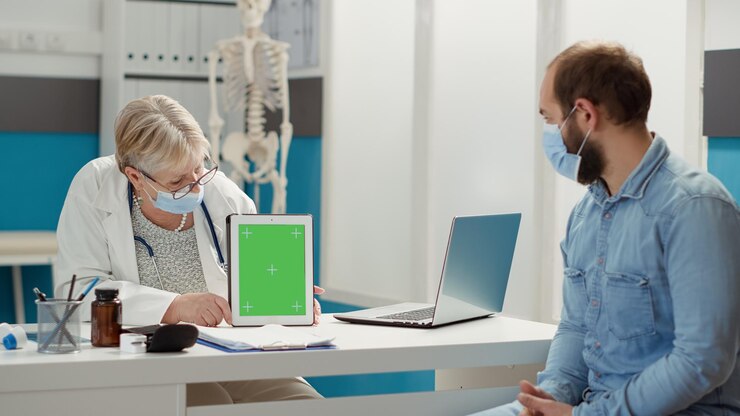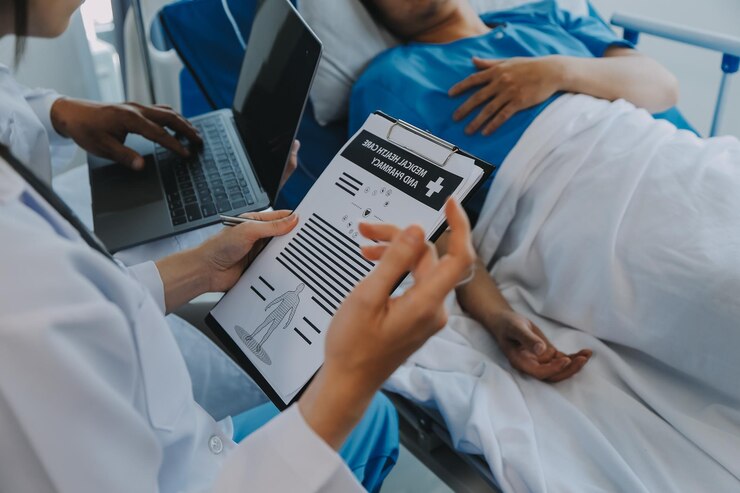Enhancing the Patient Experience with Electronic Patient Statements
Introduction
In the field of healthcare delivery, enhancing the experience of the patients is a very noble idea. One area where technology has made a big difference in patient relations is in the processing of patient statements. Paper based statements can be replaced with the modern tool known as electronic patient statements and the latter has its advantages that contribute to the company’s high level of patient satisfaction.Med Revolve Billing knows the value of these reforms and focuses on offering the outsourcing services for improving interactions with patients.
What are electronic patient statements?
The ones that are transmitted through electronic mail or through a website or a web page,” is another type of patients statement. The idea of getting rid of paper statements through this technique may further help patient address their healthcare costs better.
Benefits of Electronic Patient Statements
Electronic patient statements have significantly changed the health care business of today to the advantage of both the patients and care givers. These advantages enhance patient care input in the broad sense while simultaneously optimizing the processes of registration-booking-result storage.
1.Convenience:
A major benefit of the use of electronic patient statements is the flexibility that is associated with the use of such systems. It means that the patients are free to review their statements at their own convenience using a PC, iPad or a smart phone. This eliminates the need to wait for a paper statement to be mailed to one or the other. This affords direct visibility to critical distinguishing components such as fiscal reports.
2.Timeliness
Patient statements can be delivered electronically to the patients in this case, this is done immediately. This ensures at all times patients are up-to-date of their health care costs/finances. This timeliness leads the patients to adress any billing problem or mistake in a short span. This makes the course of the complaint more effective and the patient happier in the end.
3.Cost-Effectiveness:
The study found that using electronic patient statements can help healthcare providers cut a lot of expenses. Some of which in the operational aspect they will be in a position to reduce of which includesPRINTING AND POSTAGE of paper statements. They can then be spent on the patient, or other aspects of the health care system that are just as much in the interests of the provider as they are in the interests of the patient.
4.Environmental Impact:
Yet another benefit of electronic patient statements is that they would be friendly to the environment. It limits the use of papers statements hence helping in waste management of the environment resources. As a result, using electronic patient statements is more sustainable decision compared to the tradition paper ones in view of the increasing attentiveness to the environmental issues in healthcare sector.

5.Increased Safety and Privacy:
Compared with typical paper statements, digital patient invoices give more protection and confidentiality. Encryption can also be on the electronic invoices so as to safely store details of the patients. Thus, it plays a big role when it comes to minimizing instances of hacking into data or even stealing a person’s identification. All these brings an extra security which in turn brings about peace for the patients as well as the heath care providers.
6.Better Involvement of the Patients:
Also, patient loyalty can also be increased by electronic communication concerning expected monetary contributions towards services provided by patients. It shall be convenient for them to regulate the amount of money they spend on health care, they can see an insurance coverage and make decisions on where the money should go as to the needs of health care. This leads to increases in transparency which can create solutions that improve the relationships between providers and/or consumers in the generation of better results on healthcare overall.
How Electronic Patient Statements Improve the Patient Experience
Largely due to electronic patient statements, the healthcare sector has evolved as has the role of patients with their funds. There are several consequences with this, which enhance the general quality of the experience of the person in receiving the treatment. Not only payment processes but also transparency and less misunderstanding in the company can be improved by it. Which in turn, brings satisfaction of those who seek medical attention higher as compared to his finding.
1.Transparency:
Nevertheless, improved transparency of electronic medical bills is not the only advantage it has. All the clients thus need is to log into the account to make sure that they have been charged appropriately, and the amount they need to pay. This clarity enhances the customer journey by reducing the risks of misunderstanding between health companies and customers.
2.Accessibility
Patients can easily have access to view and regulate their healthcare expenses through receiving electronic statements through secure web connections. For this reason, people manage their healthcare costs, meaning that the patient is knowledgeable and involved in their treatment.
3.Secure Payment Options:
The accounts receivables of patients are often settled from electronic statements, that means they also have secure payment options like credit/debit card. This is an easy and safe mode for patients to pay their medical bills. It does away with the need to write checks and do them physically, yet the option is technically humble and simple.
4.Clarity and Understanding:
As a result, patients should not be confused and electronic invoices should be clear and easily understandable. Hence, among others they could contain information on fees, insurance and payment due dates. It enables people start taking informed decisions on health and it is clear concerning what is expected of them financially.
5.Personalized Communication:
Patient statements may contain relevant information/instructions particular to the documented medical need(s) of the patient and may be e-mailed to the patient. As an informative and useful mode of communication, this special presentation enhances patient satisfaction in the context of giving appropriate and useful information to manage health and finance affiliated to the disease.
Med Revolve Billing Is Providing A Comprehensive Guide On The Role of Technology in Healthcare
Technology is now becoming more vital to healthcare today acquiring positive impacts on the results of the patients and change the manner through which services are being rendered. This paper presents electronic patient statements as one of the ways through which technology is affecting the field of healthcare and giving a sneak preview into what patient-centered healthcare may be like in the near future.
1.Electronic Health Records (EHRs):
Many healthcare organisations are transitioning from normal paper based records to electronic heath records also known as EHRs to support the sharing of patient information across care givers. EHRs are the digital records of a patient’s drugs, therapies, and clinical profile. This advertises better and continuity of the expertise and specialized care needed.
2.Telemedicine:
Telemedicine has impacted the delivery of healthcare where it has adapted it, either in the rural or developing areas. Telemedicine makes several in-person visits unnecessary while providing patients with better access to treatment advice from a medical specialist. Today, the necessity of telemedicine is most important due to coronavirus disease. This makes it feasible for clients to obtain therapy while decreasing their possibility of acquiring the virus.
3.Remote Observation:
Due to advancement in technology, health institutions may now monitor their patients’ signs and other health related statistics from a distance. Such gadgets can go a long way inform of assisting those with serious sickness to notice early signs of the illnesses hence an opportunity for treatment but be granted.
4.Health Information Exchange (HIE):
Health information exchange (HIE) is defined as the safe and secure means through which patient information can be transmitted by and among medical practitioners. This also increases efficiency of care delivery since it eliminates duplication of services; and access to medical care is thus faster and cheaper.
5.Wearable Tech:
The use of consumer wearable technology also has been used over the years such as fitness bands and smartwatches. These devices gather information on heart rate, sleep habits, daily step count, and a host of other topics to help users gain a better understanding of their general health.
6.Artificial Intelligence (AI) & Machine Learning:
There are many applications for machine learning in the healthcare industry; one of them is using enormous amounts of data to identify connections that are not found by analysing them manually. Thus the effect on diagnostics, individual treatments and the planning cannot be ignored.

Challenges and Considerations
Electronic patient statements offer many advantages to patients and stakeholders. However, healthcare providers must address several challenges for effective adoption. One major concern is data security. Providers must ensure that sensitive information is protected. Additionally, patient acceptance of electronic statements is crucial. Some patients may prefer traditional methods. There are also regulatory and standardization issues to consider. Addressing these factors is essential for successful implementation.
1.Data Security:
There is always a challenge of security of this data especially when it comes to issues to do with electronic patient statements. Patients’ records should not be accessed, used, or disclosed by anybody who has no business with the patient’s health care. This also involves measures that cover patient data by use of encryption and access controls, frequent security and IT audit to check on vulnerabilities among others.
2.Patient Understanding:
Another concern is patients’ awareness and understanding of electronic statements. Many patients struggle to retrieve these statements. Healthcare providers must inform patients about the benefits of electronic statements. They should explain how to order, view, and understand these documents. This guidance can help reduce confusion and ensures patients fully utilize electronic statements. Educating patients about the process is essential, as it ultimately makes accessing electronic statements easier for them.
3.Compliance:
Other stakeholders in healthcare must ensure electronic patient statements follow HIPAA laws. They are responsible for compliance with legal standards. HIPAA sets guidelines for protecting patient information. Stakeholders must respect these rules in handling patient data. Ensuring privacy is a shared responsibility in the healthcare environment. This means ensuring electronic statements have legal requirements on security privacy and patients accessibility.
4.Technical Issues:
There could be issues with presenting electronic patient statements when is technical difficulties, for instance, systems halting, or poor connection. Heathcare organizations need contingency measures to address these issues and guarantee that technology complications do not harm clients.
Conclusion
Having electronic patient statements are very important in enhancing patient satisfaction. The discussed Med Revolve Billing has convinced them that it is convenient, clear, and provides safe communication. These statements facilitate functions and foster continuity of the provider with the patient.
Engage and Explore
How Med Revolve Billing can increase your revenue and optimize your RCM

